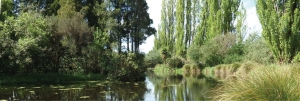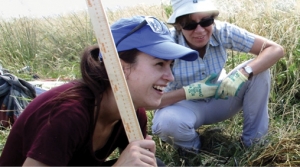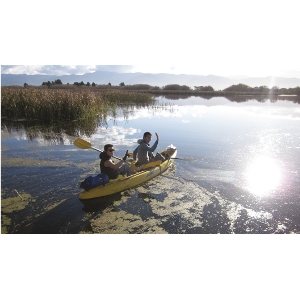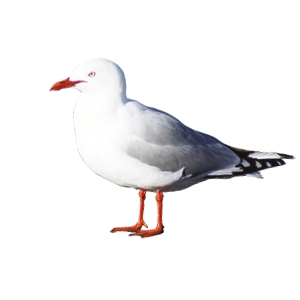Displaying items by tag: Wetlands
Wairio showcase for ecologists
Ecologists from around New Zealand visited the Wairio wetlands on 29 November with DU President Ross Cottle and Stephen Hartley, of Victoria University, as their tour guides.
The trip was part of the New Zealand Ecological Society’s annual conference in Wellington, and also included a visit to Pounui Lagoon and Onoke Spit, where Denise and Dougal Mackenzie were the guides.
Student Patrick Hipgrave and Dr Stephanie Tomscha spoke about their wetlands projects at the conference.
Stephen says Wairio have had good water levels for the past two years and the Raupo beds along the margins of stage 3 and 4 are maturing nicely.
During the tours, several royal spoonbill were spotted as well as the first signs of natural regeneration of Totara and Kahikatea in the drier sections of Stage 3 under restoration plantings of manuka and kohuhu. These were planted in 2011.
The manuka and kohuhu are now more than 3 metres tall and have shaded out the ground cover of tall fescue grass to provide the microsite conditions necessary for successful establishment of totara and kahikatea seedlings
▪ For more information on Dr Tomscha’s project, visit www.victoria.ac.nz
There’s a road through these wetlands
Gordon Pilone tells the story of how Pohangina Wetlands, now protected by a QEII National Trust covenant, were created
In 1995 Gordon and Anne Pilone bought a lifestyle block in Pohangina Valley, retiring there from Palmerston North where Gordon, originally from California, had lectured on and researched microbiology at Massey University and Taranaki-born Anne had established the best veggie and landscape gardens in town, which would prove valuable experience later.
Beside the Pilone property, sheep and bulls were grazing on a very wet paddock with some remnant kahikatea (New Zealand white pine) and other wetland flora struggling to survive. This farmland, owned by Finnis Farming Company (John and Mary Culling), had historically challenged owners’ efforts to drain it.
Across the road was the well-established Luttrells White Pine Gardens and Museum. The
gardens had walking tracks but only one small pond to attract wetland wildlife. And so began Gordon and Anne’s long-term retirement project to create a large, mature wetland. They set up the Gordon and Anne Pilone Charitable Trust in August 2000, and were joined by farmer and orthotist Chris Pullar and accountant Ian Mackrell as trustees. A fifth trustee, naturalist Dr Liz Grant, joined later, contributing her expertise in visual design and entomology science. All are Ducks Unlimited members.
Shaping the wetlandsThe development took off in 2001 when the trust employed contractor Kevin Large with his digger and bully to create the first pond near the main entry gate along Pohangina Rd. This is now known as the kahikatea block. Progress was slow as the wet dirt, being moved to create a pond, was used to develop the head and track along the bund, but it needed time to dry to get access.
Then in 2004 floods struck Pohangina Valley. Roads and bridges were washed away and Pohangina Rd was cut off when the culvert bridge at Sandy Creek was washed out. Pohangina Wetlands became even more soggy, but no damage occurred because the “wet” of the wetlands comes from aquifers and not directly from water flowing on the surface from creeks, streams or rivers.
Development slowed down after the flood because Kevin was involved with clean-up work in the valley but activity continued with the planting of native grasses, bushes and trees, mostly by Anne.
Because of the slope, all the surface water that overflows in the wet months flows to the southernmost part, the base of the damsite block. Until 2012, this water drained directly to the Weka St drain and the river. But Gordon found a way that this flow could be reused to establish a different habitat within the wetlands.
In 2006, work began on the second block (damsite block) and the biggest pond (0.54ha), which includes a sizeable island and a subterranean island – sometimes visible in the drier seasons.
Work on the “big pond” was challenging and a large track-dump truck and extra help
were required to take away the soil. It was also a large block (2.3ha) to plant out so Anne was flat out growing and planting and weeding. It is now maturing nicely and has a
“lookout”.
Once the damsite block was completed, Gordon convinced the other trustees that additional property would be fruitful for the future protection of the two main blocks.
The kahikatea block formed an L-shaped property with the newly developed damsite block, and the triangular block nestled in the “L” was being used for grazing. In 2010 this land was bought and designated the Culling block.
Instead of extensive pond development and native plantings, the block, essentially, is being allowed to “develop on its own”. Some earth was moved by Tim Luttrell with his small digger to provide a flow of surface water and a few flax, cabbage trees and Carex
geminata (cutty grass, rautahi) have been planted among the rushes.
The wetlands slope dramatically towards the Pohangina River, and the aquifer and surface water flows from north to south. This enabled the creation of ponds of varying depths and in the drier months, muddy areas form at the upside of the ponds. This habitat is invaluable because it attracts wading birds that feed in the “mudflats”. So watch out for pied stilts, heron, royal spoonbill, spur-winged plover, and dotterel.
Finnis Farming Co allowed the trust to acquire a small (0.2ha) parcel at the back of the damsite block from which Tim created a series of shallow ponds, with final exit of water overflowing to the Weka St drain.
Retention of water in this block is being aided by the planting of raupo (bulrush, cat-tail). This will create a new habitat and will allow shy and uncommon wetland birds to be seen such as fernbird, crakes and bittern. Even if this is wishful thinking – because the area is small – raupo swamps are ideal as filters for water purification.
Challenges along the way
Even with the best planning, things can go wrong and sometimes reworking is necessary, and costly. In 2006 it became noticeable that the big pond in the damsite block would not maintain its full overflow level for long after a wet period, but dropped quickly, exposing the subterranean island and pond bottom.
When walking along the track behind the head next to the drain, a wet patch was apparent so an exploratory ditch was dug along the pond below the base of the head. It exposed a cluster of rocks which seemed to form a drain into the head since water was trickling from them. It is likely this had been a very wet paddock, with drainage created from a ditch filled with rocks, and these were not noticed when the head of the big pond was developed. All agreed the remedy was to cut through the head and remove the rocks and rebuild it.
During a trustee tour after the Eketahuna earthquake in January 2014, it was obvious the poplar pond in the kahikatea block was extremely low. This pond is where the “waterworks” pipe crossing the pond head with an upright was built to allow discharge of the pond water to different levels. We thought it would be clever to be able to control the water level and form new habitats (for example, exposed muddy areas) at will. Well, Mother Nature thought differently.
The reason for the low water level became apparent when Anne found water leaking from the outlet side of the pond hidden in tall grass near the end of the pipe running through the head of the pond. On further inspection, there was a large crack in the plastic T-fitting at the base, which must have happened in the earthquake.
The T-fitting was held snugly by two posts and apparently there was not enough “give” when the earthquake hit. The assembly was removed and the pipe carrying water through the head was capped off on the inlet side of the pond. We learnt that careful thought needs to be given to the design of piping in a wetlands system.
Another example was during the development of the ponds in the kahikatea block. The main ponds there are connected by 110mm pipes allowing water to flow from one pond to the next underground rather than over the tracks, ensuring easier and drier access
for visitors.
Gordon had a bright idea to prevent clogging of the inlet of the pipes with surface debris: the inlets could be fitted with a short pipe at a 45-degree angle to submerge the inflow beneath the surface of the pond. Soon after this modification, he was surprised to find all the ponds had lower water levels than the expected overflow levels when the ponds were full.
The penny dropped and it became obvious that the inlet-angled pipe also allowed for siphoning to occur when the flow was great enough to fill the pipe and continue to flow to the level of the submerged inlet. A lesson learnt. And the solution was obvious, too – drill a hole at the attachment point of the angled pipe to allow the inflow of air, thus preventing siphoning.
Some other “oops” happen unexpectedly and require major adjustments. In 2011 Gordon began to have cramps in the calves of both legs. Peripheral arterial clogging was advanced and in 2015 he had to have both legs amputated above the knees. Now wheelchair-bound, Gordon is no longer physically active in the wetlands development, but fortunately the main work is complete.
Anne continues maintenance plantings
Tim Luttrell.
The Pilone home could not be readily renovated for wheelchair living but, fortuitously, a cottage being built across the road by Tim and Carol Luttrell became available and was purposefully built for wheelchair use. You will still see Gordon in the wetlands, but not on his tractor mowing or on his bright orange Kubota RTV.
Instead, he will be observing and taking pictures from a Timmobile, a mobility scooter renovated by Tim. So look out for Gordon on the tracks and have a chat, or come to the cottage across the road and say hi.
Visitors always welcome
The wetlands were opened to visitors on the longest day in December 2005 and are always open to visitors at no charge. A brochure is available at the entry gate on Pohangina Rd.
Probably one of the greatest joys in establishing a wetlands was seeing a kōtuku (white heron) visiting for a few hours in 2008. This has been a one-time event, though it may be that they visit when we are not in the wetlands.
Another uncommon visitor is the New Zealand royal spoonbill (kōtuku ngutupapa). A young individual was seen for several days feeding in the shallow ponds. Some flock yearly at the Foxton beach estuary nearby. Since the first bird seen in March 2007, we have had increasing numbers visit and stay for several days, sometimes in flocks as big as 13.
Another resident wetland bird that delights visitors is the dabchick (wewei). During breeding season, you can find one or two white striped headed chicks on the back of an adult with the mate diving and bringing food to the chicks.
Luttrells wetlands and kahikatea bush
Next door to Pohangina Wetlands and hidden by the magnificent tall stand of kahikatea is another developing wetlands area on the property of Tim and Carol Luttrell.
Luttrells White Pine Gardens and Museum is open any time by arrangement for a small fee. The complex is well-worth seeing and includes a walkway through kahikatea bush; tracks meandering around wetlands; and plenty of opportunity to view wetland wildlife and a comprehensive museum based on settlers in the valley.
Pohangina Village residents are fortunate to have such an extensive wildlife habitat of 10ha (25 acres), combined, within walking distance of their homes. To assure it is kept in perpetuity for future residents, the Pilones and Luttrells have been granted Queen Elizabeth II National Trust covenants on the portion of their properties that constitute wetlands and bush. We are grateful and honoured that the QEII National Trust has regarded the properties as worthy of protection.
Now that the future of the two wetlands are secure, it is interesting to speculate what form of management might develop for their continued maintenance. Pohangina Wetlands, now under the auspices of the Gordon and Anne Pilone Charitable Trust, already has some long-term management permanency in the “turnover” of trustees, as well as financial assurance as the beneficiary of the Pilone estate. The Luttrell wetlands and kahikatea bush belong to the family, but the long-term future is unclear.
As the two properties are beside each other, separated only by a road, and wildlife interaction is seamless, it seems logical that the two properties be managed as one. In Manawatu, there already are open space properties being managed by some level of government using subcontracted maintenance. This might be considered for the future management of the “Pohangina Village Wetlands”.
We look forward to seeing you in the “wetlands a road runs through”.
Visit www.pohangina.org for more information.
Nurse trees give saplands a headstart
Stevie Waring has been looking into the benefits of nurse trees in wetlands restoration at Wairio.
Swamps are a category of wetland that are dominated by flood-tolerant trees, which thrive in soils that are nutrient-rich, but occasionally boggy or flooded.
Historically, New Zealand’s swamps were dominated by large podocarp trees,especially kahikatea andtotara, but these were targeted as valuable timber throughout the 19th century. Thereafter, land conversions for urban expansion and agriculture
continued to degrade swamps. A primary goal of wetland restoration is to revegetate sites with native trees.
However, up to 70 per cent of sapling trees can die within the first year of planting. The death of trees increases the financial costs of wetland restoration while reducing the benefits to nature and the morale of project participants. Put simply, dead trees reduce the feasibility of restoration of wetland swamps.
Nearby plants can affect the earlier years of a sapling’s life. For example, highly competitive perennial grasses can shade and outcompete the saplings for light and soil resources. On the other
hand, having neighbours may benefit the sapling.
In exchange for sugars made by the plant in photosynthesis, AMF provide the plant with soil nutrients. Because sapling establishment is influenced by nurse trees over such a wide range of site conditions, nurse effects may be particularly important for trees.
Little is known about how nurse trees affect establishing saplings in wetland restoration. Can strategically planting saplings near nurse trees increase their survival and growth rates? Or are other
site factors such as soil moisture more important for sapling survival?
In my MSc thesis, in the Centre for Biodiversity and Restoration
Ecology at Victoria University, I sought to identify how nurse
trees improve establishment of two podocarp tree species
planted as part of a wetland swamp forest restoration.
In collaboration with Ducks Unlimited and the Department of Conservation, I monitored the survival and growth of kahikatea
(Dacrycarpus dacrydioides) and totara (Podocarpus totara) saplings planted with or without an established nurse trees at the Wairio wetland. The wetland connects a large, ecologically, culturally and recreationally important wetland complex that spans the Wairarapa valley. However, the increased nutrient inputs from livestock and chemical fertilisers and the introduction of pasture plant species have led to a weed-dominated environment.
During restoration, highly competitive perennial grasses can shade and outcompete the newly planted, slowgrowing podocarps. In addition, the complex hydrology of the site leads to species-specific spatial patterns of mortality and growth.
In my studies, I tested whether the presence of a woody nurse tree
(manuka, pittosporum or coprosma) influenced the survival and growth of kahikatea and totara over the critical first year of establishment. I monitored soil moisture, the pH and oxygen status of soils, root-available nutrients, and soil carbon content under saplings planted with and without nurses. I also quantified the abundance of spores of AMF fungi under all saplings.
Hydrological and chemical characteristics of Matthews Lagoon and Boggy Pond, Wairarapa
Essential information for the decision making process of wetland restoration.
Wetlands are areas where lands transition to water bodies. Because of this special geomorphological setting, wetlands play important roles in flood control, nutrient retention, and water storage. In New Zealand, less than 10 percent of the original wetlands have survived since human settlement. Many of the remaining wetlands are still under threat from water quality degradation, invasive species, and changes in hydrological regime.
Wetland restoration is the process of bringing the structure and function of a wetland back to its original state. Although specific objectives may vary between projects, three major objectives of wetland restoration are restoration of wetland function, restoration of wetland structure, and restoration of traditional landscape and land-use practices. In order to ensure the success of a wetland restoration project, a good understanding of the hydrological process in the wetland is the first step.
Boggy Pond and Matthews Lagoon on the eastern edge of Lake Wairarapa in the Wellington Region were formed as a result of the deposition of sand dunes on the eastern shore and changes in river courses between floods. They were modified by a series of engineering works under the lower Wairarapa valley development scheme in the 1980s.
Boggy Pond is cut off from Lake Wairarapa and surrounding wetlands by a road and stopbank, leaving a more stable water level compared to its original state. To analyse the water and nutrient balance in these two wetlands, factors such as surface flows, surface water levels, groundwater levels, rainfall, climate data, and water quality were assessed at various monitoring stations in this study. It is believed that Matthews Lagoon and Boggy Pond have completely different water regimes. Matthews Lagoon receives surface inflow from the Te Hopai drainage scheme and discharges to Oporua floodway, but Boggy Pond only has rainfall as the water input.
The results from the water balance analysis seem to support this assumption. An unexpected finding in Matthews Lagoon suggests that water might bypass the main wetland, creating a shortcut between the inlet and outlet. As a result, the nutrient removal ability was considerably weakened by this bypass because of the short water retention time.
In Boggy Pond, there may be an unknown water input which could adversely affect the
Some recommendations are given on the restoration of these two wetlands. First, set proper objectives according to their different functions. Second, enhance the nutrient removal ability of Matthews Lagoon by harvesting plants, removing old sediments, and creating a more evenly distributed flow across the wetland throughout the year. Third, restore the natural water level fluctuations and improve water quality in Boggy Pond by identifying any unknown water inputs first.
To view Cheng Shi’s full thesis go to:http://researcharchive.vuw.ac.nz/
Wairio under scrutiny
Ecological restoration of Wairio Wetland, Lake Wairarapa
The response of native wetland vegetation to eutrophication and re-vegitation management strategies.
Wetlands are highly productive ecosystems that support abundant native fauna and flora and provide many essential functions and services, for example, water purification, erosion stabilisation, floodwater storage, groundwater recharge, peat accumulation and biogeochemical cycling.
Wetland disturbance can cause altered hydrological regimes, invasive species introduction, soil and water eutrophication, habitat fragmentation and reductions in native fauna and flora leading to an overall reduced functionality.
Wairio Wetland on the eastern shores of Lake Wairarapa forms a part of Wairarapa-Moana, the largest wetland complex in the lower North Island. Historically Wairio was an abundant kahikatea swamp forest, with a diverse range of waterfowl, waders and freshwater fish. However, the wetland was adversely affected by a draining scheme during the 1960s and 1970s, the construction of Parera Road, and the invasion of willow trees planted for erosion control.
Draining of the wetland, division from nearby lagoons and ponds, nitrogen and phosphorus build-up in waterways and exotic weed invasion all contributed to the poor state of the wetland. In 2005, Ducks Unlimited (DU) in conjunction with the Department of Conservation (DOC) and members of the local community formed the Wairio Wetland
Restoration Committee to manage and restore the wetland to its presettlement state.
This thesis reports on two studies undertaken at Wairio Wetland with aims to inform future restoration efforts.
The short duration of the experiment and summer drought conditions may have obscured the above-ground visual responses of the plant community to nutrient addition: therefore, further continuation of this experiment is advised. Variable survival rates of previous plantings, and uncertainty about the most cost-effective practice under current site conditions, provided the impetus for this study.
Therefore the second study, conducted between July 2011 and January 2014 in Stage 3 of the wetland, further investigates the effects of various management treatments on establishment of native woody vegetation.
Note: Both the experiments described in the above thesis are on-going. Stephen Hartley who is Deputy Director for the Victoria University Centre for Biodiversity and Restoration Ecology and is a Senior Lecturer in Conservation and Ecology, will continue to monitor the growth of trees in Stage 3, and a Belgian intern student will re-survey the nutrient enrichment plots in Stage 2.
To view Aprille Gillon’s full thesis go to:-
http://researcharchive.vuw.ac
Results showed that interspecific competition and hydrology appeared to be the main processes influencing the establishment of native plantings at Wairio Wetland, with plant mortality greatest in the first year after planting. Water logging, in particular, was detrimental to establishment of all species at the site except D. dacridioides. Topsoil excavation and the planting of nurse trees at 1.5m spacing was the most effective management treatment combination promoting survival of plantings at Wairio.
However, the success of management treatments varied greatly between species at the site and had different impacts on plant growth. Topsoil excavation was beneficial to survival of D. dacridioides and C. robusta but detrimental to growth of C. australis, O. virgata, C. propinqua, Ptenuifolium and L. scoparium.
The concurrent planting of nurse trees with focal trees was beneficial to the survival of D. dacridioides, growth of P. totara, and survival and growth of C. australis. The planting of nurse trees further apart at 1.5m compared to 0.75m had a positive effect on the survival of C. propinqua and P. tenuifolium, and survival and growth of L. scoparium. Weed mats were beneficial to survival of O. virgata and growth of L. scoparium but detrimental to growth of D. dacridioides. These management treatments can be used in future revegetation efforts at Wairio Wetland and potentially in other wetland restoration projects throughout New Zealand.
Birds in peril World Over
Bird species the world over are victims of human activities and thoughtlessness. Who would have thought our local New Zealand sea birds (red beaked gulls in particular), could ever reach a point when their numbers would dwindle and the possibility of their extinction could be just a matter of years away?
In Britain too, there is a dramatic decline in farmland birds – a decline of 55 percent since 1970. And humans are the cause. There are more and more of us and therefore, more and more land is required to grow our food.
Water and wetland birds in Britain have fallen by 12 percent in five years, seabirds have declined by nine percent and although woodland birds seem to have remained stable in recent years, they are down by 28 percent since 1975.
The secret life of male bitterns
Finally revealed by DU transmitters
From the President
This adversely impacts on water levels in our wetlands and the biodiversity they support. We cannot ignore that climate change is having an effect.
What can we do about it?
which the DU Board will be addressing over the next 12 months.
The dates for this year’s AGM are at the Distinction Hotel, Palmerston North, for the weekend of Friday July 31 to Sunday August 2, 2015.
John Cheyne
Wetlands help reduce nitrates (USA)
Working in the edge of the wetlands







